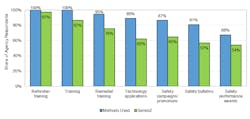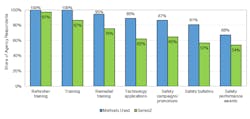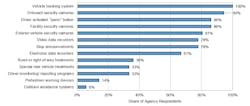Managing onboard safety
With the understanding that many transit professionals throughout the nation experience similar safety challenges, the Transportation Research Board’s (TRB) Transit Cooperative Research Program (TCRP) funded TCRP Synthesis 126, with the purpose of documenting and sharing successful practices and bus operator training programs that have been effective in reducing transit bus accidents and incidents. As part of the data collection efforts of the study, 37 transit agencies (representing 23 states) were surveyed, and 11 case study agencies were interviewed.
Survey responses revealed that 87% of respondent agencies have an accident review board, 94% of which task their board with preventability determinations. Most agencies interviewed (92%) track causal or contributing factors of safety events, which is important because factors must be measured to be managed effectively.
Concerning bus operator training, agencies reported refresher training as the most successful mitigation method used to prevent safety issues, as shown in Figure 1. More than half of the agencies indicated that their new operator training curriculum has been tailored to address agency-specific prevalent incidents, and those that utilize training simulators indicated they are used to primarily target common areas of risk. The most preferred delivery method for training is on-site, instructor-led classroom training.
Figure 1. Methods used to mitigate identified safety-related issues and success rates
When asked about the use of technologies, all responding agencies indicated the use of vehicle tracking systems, while only 6% indicated the use of collision avoidance systems, as displayed in Figure 2. When opinions of success were collected, nearly half of the responding agencies indicated that the use of video and/or operator monitoring programs have been the most successful.
Figure 2. Share of technology use by type
Key trends that were echoed across agencies that reported model practices were the importance of regular refresher training and agency-wide accountability. Survey respondents reported that telemetry-based driver monitoring and video surveillance systems are useful and successful due to the ability to identify areas of risk for which events have not yet occurred, allowing for proactive risk mitigation.
After receiving survey responses, the research team chose eleven case study agencies to interview in-depth. The case study agencies were chosen carefully to ensure geographical and agency size distributions were considered to make the findings applicable to all transit agencies. Figure 3 displays the case study agencies geographically with a legend to identify the agency’s size.
Figure 3. Case study locations
Each of the eleven case study agencies that were interviewed discussed topics such as areas of greatest concern; training programs and initiatives; technology solutions; safety campaigns, incentives and awards; and the role of the chief executive officer or general manager.
1. Charlotte Area Transit System’s (CATS) training program was overhauled in 2014 to improve the consistency and structure of bus operator training. CATS buses are equipped with onboard audio/video recording, which was indicated as being the most effective technology in use by the agency due to the ability to substantiate complaints, identify poorly performing operators and address issues prior to an incident occurring. CATS launched the “CATS See Say” app to enable riders to alert transit police if they notice something that seems concerning.
2. In 2008, Madison Metro in Wisconsin began the process of revamping its training curriculum. Madison Metro buses are equipped with audio/video surveillance equipment, which was reported as beneficial, allowing for event-specific one-on-one coaching, counseling of bus operators and for customer complaint investigations. Metro credits open communication throughout the entire agency as the most successful approach to increased safety.
3. Greater Bridgeport Transit (GBT) in Connecticut indicated that on-board surveillance coupled with Automatic Vehicle Location (AVL) technology allows for holistic understanding of safety events. GBT indicated teamwork is the most successful approach taken.
4. Greater Cleveland RTA installed telemetry-based driver-monitoring system (DMS) equipment fleet-wide in 2014 to help protect its operators, reduce costs associated with risky driving behaviors and create a safer experience for riders. When asked to comment on the keys to the success of RTA’s safety program, staff cited that the DMS, open and honest dialogue with employees, a relentless pursuit of improvement, recognizing and rewarding employees for exceptional safety performance, and using teamwork between the Safety and Operations Departments to create a true atmosphere of safety.
5. Jacksonville Transportation Authority (JTA) installed DMS technology on 50 fixed route buses in 2015, and was in the process of fitting their entire bus fleet at the time of the study. JTA also reported successes in the use of a training simulator for their bus operators, noting it affords operators the opportunity to associate muscle memory, reaction time, problem solving, decision-making and judgment all at the same time in a repetitive manner with none of the repercussions that would be associated with the same scenarios in the real world.
6. The Kansas City Area Transit Authority (KCATA) initiated a comprehensive corrective action five-point plan focusing on engineering, education, enforcement, encouragement and evaluation. KCATA credits their safety improvement success, at least partially, to their evaluation program, which monitors and tracks established metrics.
7. King County Metro in Washington State contracted with King County Police for an Operator Assaults Reduction Initiative. As part of this program, police trainers visit all Metro venues to explain the initiative and to educate operators on techniques they can use, such as “verbal judo” and other common-sense tools, to de-escalate tense situations. This initiative was reported as successful by the agency with a 6.1% decrease in operator assaults from 2014-2015.
8. All Lane Transit District (LTD) buses in Oregon are equipped with video surveillance equipment, with up to 16 cameras per bus and at least 10 cameras on smaller vehicles. LTD reported using a telemetry-based DMS on a trial basis on a select number of its buses. Ultimately, it was determined that the system was not a good match for LTD’s needs, due in part to the cost burden given the small size of the agency.
9. Solano County Transit (SolTrans) in California representatives explained: “Positivity and safety culture are interrelated. At SolTrans, employees are treated as internal customers, with the understanding that an agency’s employees are the most important people in an organization. It is necessary to thank them for a job well done and provide them with the opportunity to provide good customer service.”
10. Every fall, the Tri-County Metropolitan Transportation District (TriMet) in Oregon rolls out its “Be Seen, Be Safe” campaign, which stresses the importance of wearing bright clothing, reflective materials and personal lights to be visible, especially during the fall season when daylight savings time ends. TriMet runs a safety awareness campaign every spring as well, and the 2016 theme was “Stay Alert, Stay Alive”.
11. In May of 2014, the Utah Transit Authority (UTA) installed a telemetry-based DMS on its entire fleet of buses. The DMS is not only used for incident investigation, but the system also provides bus operators with an extra level of protection via capabilities to manually activate recording in the case of circumstances such as robbery, unruly passengers and road rage. Additionally, the DMS gives UTA the opportunity to track incidents by type, allowing for focused coaching on current prevalent incidents.
All case study agencies shared certain qualities and characteristics, including an across-the-agency philosophy recognizing the importance of employee participation and input. All case study agencies:
- Have adopted and enforce distracted driving/wireless distraction policies and procedures. The majority of the agencies have zero tolerance for these violations;
- Applied multiple approaches to address areas of safety concern;
- Work across teams to improve transit safety, and this process/ culture is set and supported by the CEO/GM;
- Conduct thorough accident and incident investigations, and use audio/video recordings in their examination. Each agency has an accident review board or a body with similar function that includes representation from across teams;
- Have a structured process for data collection, analysis, and review;
- Provide regular, comprehensive refresher training for their bus operators. Each agency reported success in its safety improvement programs and identified training as a central element;
- Cited the value of using actual onboard video and audio recordings in refresher and remedial training, and in counseling sessions with specific bus operators; and
- Recognized the value of their employees to their organizations. Each provided bus operators with opportunities for input and engagement with transit agency leadership.
The use of telemetric DMS by four case example locations and their reported successes are noteworthy. The agencies discussed the value of these systems for modifying driver behavior and improving system safety.
Key takeaways include the emphasized importance of effective and regularly updated new operator, refresher, and remedial training. The use of telemetry-based driver monitoring systems was found to be more prevalent across the industry. These systems automatically collect data for analysis of many safety-related events such as collision incidents, near misses, speeding and distracted driving, allowing proactive corrective actions to be undertaken by the transit agency. Successful programs utilize multipronged or multifaceted coordinated efforts to address transit safety. In all case study agencies, there was no single method identified that led to improved safety. However, strategies that include multiple approaches to improve bus safety do find success.
The research team would like to acknowledge TRB’s TCRP, which sponsored the research, with a special thanks to Mariela Garcia-Colberg, the National Academies staff contact for the study. For more information, please read the entire TCRP Synthesis 126.


